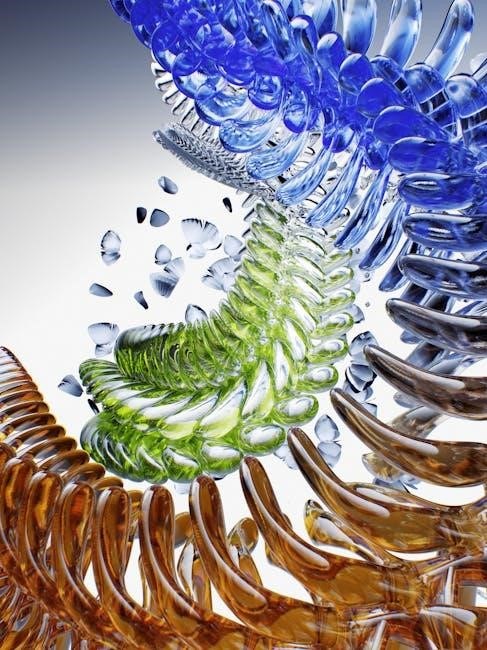dynamics of fluid flow pdf
Fluid dynamics explores the behavior of fluids under various forces‚ emphasizing flow patterns‚ forces‚ and energy transfer. It is crucial in engineering‚ aerospace‚ and environmental studies.
1.1. Definition and Importance of Fluid Flow
Fluid flow refers to the movement of fluids (liquids or gases) driven by external or internal forces. It is a fundamental concept in physics and engineering‚ describing how fluids behave under various conditions. Understanding fluid flow is crucial for designing systems like pipelines‚ turbines‚ and aircraft‚ as well as studying natural phenomena such as ocean currents and weather patterns. Accurate analysis of fluid dynamics ensures efficiency‚ safety‚ and performance in numerous industrial and environmental applications‚ making it indispensable in modern engineering and scientific research.

1.2. Historical Development of Fluid Dynamics
Fluid dynamics traces its roots to early studies of fluid behavior by scientists like Leonardo da Vinci and Isaac Newton. The 18th century saw significant advancements with Euler’s equations of motion for ideal fluids. Later‚ Navier and Stokes introduced viscosity‚ forming the Navier-Stokes equations‚ which remain foundational. The 20th century brought computational fluid dynamics (CFD)‚ revolutionizing simulations. Historical milestones include the Oberbeck-Boussinesq system and experimental techniques‚ shaping modern understanding and applications of fluid flow in engineering and physics.

Fundamental Principles of Fluid Flow
Fluid flow is governed by principles like mass conservation‚ momentum transfer‚ and energy exchange‚ essential for understanding dynamics in various engineering and natural systems.
2.1. Basic Concepts: Streamlines‚ Pathlines‚ and Streaklines
Streamlines represent the instantaneous direction of fluid flow‚ while pathlines show the trajectory of particles over time. Streaklines trace the path of particles released from a point. These concepts visualize fluid motion‚ aiding in understanding flow patterns‚ especially in steady and unsteady conditions. Streamlines are fixed in steady flow but vary with time in unsteady flow‚ as noted in various studies on fluid dynamics and particle tracking methods.
2.2. Steady and Unsteady Flow
Steady flow occurs when fluid properties remain constant over time at any point‚ while unsteady flow changes with time. Steady flow simplifies analysis‚ as it eliminates time-dependent terms in equations. Unsteady flow‚ however‚ requires complex numerical methods to solve‚ as it involves transient phenomena. Both types are fundamental in fluid dynamics‚ with applications in engineering and natural systems. The distinction between steady and unsteady flow is crucial for accurate modeling and prediction of fluid behavior in various scenarios.
Types of Fluid Flow
Fluid flow is classified into laminar and turbulent‚ based on velocity profiles and particle paths. Compressible and incompressible flows depend on density variations‚ crucial in engineering and natural systems.
3;1. Laminar and Turbulent Flow
Laminar flow is smooth and orderly‚ with fluid particles moving in parallel layers. Turbulent flow is chaotic‚ with eddies and mixing across streamlines. Reynolds number determines the transition between these regimes. Laminar flow occurs at low Reynolds numbers‚ while turbulent flow dominates at high Reynolds numbers. Understanding these regimes is critical for engineering applications‚ as turbulence increases energy losses and mixing‚ affecting system performance and efficiency. Both types of flow are essential in natural and industrial fluid dynamics systems.
3.2. Compressible and Incompressible Flow
Compressible flow involves fluids where density changes significantly due to pressure variations‚ common in gases at high speeds. Incompressible flow assumes constant density‚ typical for liquids or gases at low velocities. The distinction is crucial in aerospace and pipeline engineering. Compressible flow equations account for density variations‚ while incompressible models simplify calculations by neglecting these changes. Accurate modeling of each type ensures efficient and safe system design across various engineering applications.

Governing Equations of Fluid Dynamics
The foundation of fluid dynamics lies in the Navier-Stokes equations‚ which describe how velocity‚ pressure‚ and external forces affect fluid flow over time and space.
4.1. Navier-Stokes Equations
The Navier-Stokes equations are a set of nonlinear partial differential equations that describe the motion of fluid substances. They account for inertia‚ viscosity‚ and external forces‚ forming the cornerstone of fluid dynamics. These equations are crucial for solving problems in engineering‚ meteorology‚ and oceanography‚ providing insights into flow patterns‚ turbulence‚ and heat transfer. Researchers like NV Burmasheva have studied their solvability‚ ensuring accurate predictions in various applications.
4.2. Oberbeck-Boussinesq System
The Oberbeck-Boussinesq system simplifies the Navier-Stokes equations for incompressible fluids with buoyancy effects. It assumes density variations are negligible except in the buoyancy term‚ making it ideal for thermal convection studies. This system is widely used in engineering and environmental applications‚ such as heat transfer and natural convection. Recent research‚ like the work by V. Privalova‚ has provided exact solutions‚ enhancing its utility in modeling complex fluid flow scenarios with precision and efficiency.
Computational Fluid Dynamics (CFD)
CFD uses computers and numerical methods to solve fluid flow problems. It simulates fluid behavior‚ heat transfer‚ and mass transport‚ aiding in engineering design and optimization.
5.1; Numerical Methods in CFD
CFD employs numerical methods like finite difference‚ finite element‚ and spectral techniques to discretize governing equations. These methods solve fluid flow problems by converting differential equations into algebraic forms. Techniques such as upwinding and turbulence modeling enhance accuracy. Mesh generation is critical for defining computational domains. Numerical stability and convergence are ensured through iterative solvers. These methods enable simulations of complex flows‚ including turbulence‚ heat transfer‚ and multiphase systems‚ providing insights for engineering and scientific applications.
5.2. Applications of CFD in Fluid Flow Analysis
CFD is widely applied in aerospace‚ automotive‚ and chemical industries to optimize fluid flow systems. It aids in designing turbines‚ pipelines‚ and heat exchangers‚ improving efficiency and reducing costs. CFD also models environmental flows‚ such as ocean currents and air quality‚ supporting climate studies. In biomedical engineering‚ it simulates blood flow for medical device design. Additionally‚ CFD enhances industrial processes‚ like mixing and combustion‚ ensuring safety and performance. Its versatility makes it a vital tool across diverse sectors for fluid-related challenges.

Engineering Applications of Fluid Flow Dynamics
Fluid flow dynamics is crucial in designing pipelines‚ turbines‚ and hydraulic systems‚ ensuring efficiency‚ safety‚ and optimal performance across various engineering disciplines and industrial applications.
6.1. Aerospace Engineering
In aerospace engineering‚ fluid dynamics is pivotal for designing aircraft‚ spacecraft‚ and missiles. It analyzes aerodynamics‚ propulsion systems‚ and heat transfer‚ ensuring efficient and stable flight performance. Researchers use computational fluid dynamics (CFD) to simulate airflow around vehicles‚ optimizing shapes for minimal drag and maximal lift. Studies on compressible flows and shock waves are critical for supersonic and hypersonic vehicles. Additionally‚ fluid flow dynamics informs the design of fuel systems and thermal management‚ enhancing overall aerospace vehicle efficiency and reliability.
6.2. Chemical and Civil Engineering
Fluid dynamics plays a crucial role in chemical and civil engineering. In chemical engineering‚ it aids in designing mixing processes‚ pipelines‚ and reactors‚ ensuring efficient fluid transport. Computational fluid dynamics (CFD) is used to optimize flow systems‚ minimizing energy consumption and maximizing output. In civil engineering‚ fluid dynamics informs the design of water supply systems‚ dams‚ and river flow management. It also helps in analyzing hydraulic structures and ensuring their stability under various flow conditions‚ critical for urban planning and disaster prevention.

Advanced Topics in Fluid Flow
Advanced topics include phase transitions‚ ice crystal growth‚ and magnetic field effects on fluid dynamics‚ offering insights into complex flow behaviors and modern research directions.
7.1. Phase Transitions and Ice Crystal Growth
Phase transitions in fluid flow involve dynamic interactions between liquid and solid states‚ such as ice crystal growth. Research explores how small surface irregularities influence crystal formation at high Reynolds numbers. Experimental and computational methods‚ including phase field crystal (PFC) models‚ are used to simulate these phenomena. Understanding these transitions is crucial for applications like materials science and environmental studies‚ where ice crystal behavior impacts heat transfer and fluid efficiency.
7.2. Magnetic Field Effects on Fluid Flow
Magnetic fields significantly influence fluid flow dynamics‚ particularly in conducting fluids. Studies examine the evolution of viscous conducting fluids on rotating plates under magnetic fields‚ revealing complex flow behaviors. Analytical solutions and computational methods‚ such as CFD‚ are employed to analyze these interactions. Magnetic fields can induce unique flow patterns‚ affecting stability and efficiency in various engineering applications. This research is vital for understanding and controlling magnetohydrodynamic phenomena in materials science and industrial processes.
Experimental Methods in Fluid Dynamics
Experimental methods involve high-speed fluid flow studies‚ heat transfer analysis‚ and phase field crystal models combined with CFD to model phenomena like ice crystal growth and flow dynamics.
8.1. High-Speed Fluid Flow Experiments
High-speed fluid flow experiments focus on capturing dynamic phenomena like shock waves‚ turbulence‚ and phase transitions. Techniques such as shadowgraphy and particle imaging velocimetry are employed to visualize and measure rapid flow behaviors. These experiments are crucial in aerospace engineering for studying supersonic flows and nozzle designs. Additionally‚ they explore magnetic field effects on fluid dynamics‚ revealing complex interactions. Such studies also investigate ice crystal growth in flows‚ combining phase field crystal models with CFD for precise simulations.

8.2. Heat Transfer and Efficiency Studies
Heat transfer and efficiency studies examine how fluid flow affects thermal energy exchange. Experimental methods analyze dynamic fluid movements and their impact on heat transfer efficiency. Research focuses on manipulating small liquid amounts at high speeds to enhance thermal management. Phase field crystal models combined with CFD simulate ice crystal growth in flows‚ revealing intricate heat transfer mechanisms. These studies optimize industrial processes and improve thermal efficiency in various engineering applications.

Future Trends in Fluid Flow Research
Future trends include advancements in computational methods and integrating phase field crystal models with CFD to study complex fluid behaviors and optimize real-world applications.

9.1. Modern Numerical Techniques
Modern numerical techniques in fluid flow research involve advanced algorithms and computational methods to solve complex flow problems. High-order discretization schemes and machine learning integration are emerging trends. These methods enhance accuracy and efficiency in simulating phenomena like turbulence and phase transitions. Computational tools now handle multi-scale problems‚ enabling detailed analysis of fluid behavior under various conditions. Such advancements are crucial for optimizing engineering designs and understanding intricate fluid dynamics in aerospace and environmental applications.

9;2. Combining Phase Field Crystal Models with CFD
Combining Phase Field Crystal (PFC) models with Computational Fluid Dynamics (CFD) enables advanced modeling of fluid-solid interactions. The PFC method captures crystal growth dynamics‚ while CFD simulates fluid flow‚ offering insights into phenomena like ice crystal formation. This integration enhances predictions of phase transitions and microstructure evolution in fluids. Applications include materials science and climate modeling‚ where understanding fluid-crystal interactions is critical. This approach bridges microscopic and macroscopic scales‚ advancing fluid flow research in complex systems.
